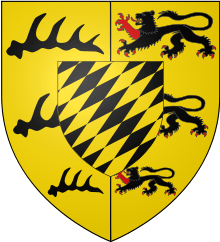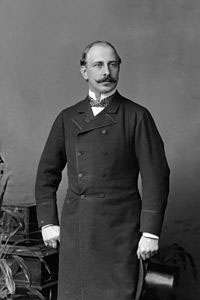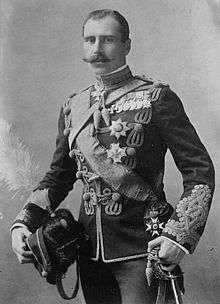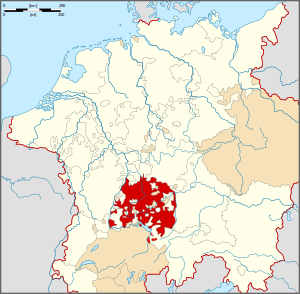Duke of Teck
_Scheibler429ps.jpg)
The Duke of Teck was, in medieval times, a title borne by the head of a branch line of the German ducal House of Zähringen from 1187 to 1439, known historically as the first House of Teck. His territory was centered on Teck Castle in Swabia.
The title was recreated in 1871 in the Kingdom of Württemberg for a cousin of its king, Charles I, whose descendants settled in the United Kingdom and married into the British Royal Family.
First House of Teck
Adalbert I, son of Duke Conrad I of Zähringen, inherited his father's Swabian possessions around Teck Castle between Kirchheim and Owen. After the death of his brother Duke Berthold IV in 1186, Adalbert adopted the title of "Duke of Teck". His descendant Duke Conrad II upon the death of King Rudolph I of Germany in 1291 even became a candidate for the election as King of the Romans, but probably was slain by his opponent Siegfried of Westerburg, Archbishop of Cologne, the next year.
In the 13th century, the family divided into the lines of Teck-Oberndorf and Teck-Owen. The Dukes of Teck-Oberndorf died out in 1363 and Frederick of Teck-Owen sold their possessions to the Counts of Hohenberg. In 1365, the Dukes of Teck-Owen came into the possession of Mindelheim but had to sell their lands around the castle Teck to the Counts of Württemberg in 1381. The last member of that line, Louis of Teck, Patriarch of Aquileia from 1412, died in 1439.
In 1495 Emperor Maximilian I elevated Count Eberhard von Württemberg to the status of reigning Duke (Herzog) of Würrtemberg, also granting him the defunct title, "Duke of Teck". However, the title was not borne independently by any member or branch of that dynasty.
Württemberg cadet branch

Alexander von Württemberg (1804-1885), the youngest son of Duke Louis, re-established the collateral line of the Dukes of Teck by his morganatic marriage with the Hungarian countess Claudine Rhédey von Kis-Rhéde (1812-1841). His children were banned from the succession in the Kingdom of Württemberg, therefore his son Francis (1837-1900) was born as a "Count of Hohenstein", a title which his mother had received from the hands of Emperor Ferdinand I of Austria.
In 1863, King William I of Württemberg created the title of a "Prince of Teck" with the style Serene Highness (Durchlaucht) for Francis. In 1866 he married Princess Mary Adelaide of Cambridge, a member of the British Royal Family and granddaughter of King George III. As the couple had to live off Mary Adelaide's Parliamentary annuity, since the Duke of Teck had little income, the Duke and Duchess of Teck lived in London. In 1871, King Charles I of Württemberg awarded Francis the higher title Duke of Teck. In 1887, Queen Victoria, the Duchess of Teck's cousin, granted the Duke of Teck the style His Highness.
In 1893, Francis' daughter, Princess Victoria Mary of Teck married Prince George, Duke of York who later reigned as King George V. When the 1st Duke of Teck died in 1900, the dukedom passed to his eldest son, HSH Prince Adolphus of Teck. King George V granted the 2nd Duke of Teck the style His Highness in 1911.
The title existed until 1917, when during World War I, anti-German sentiment in the United Kingdom led the British monarch to relinquish all German titles on behalf of himself and his family members living in the British Empire. King George V changed the name of the royal house from the Germanic House of Saxe-Coburg-Gotha to the more English sounding House of Windsor. He officially renounced the use of all German titles for himself and for all members of the British Royal Family who were domiciled in his realms.
In response to this, the Duke of Teck renounced his title of a Prince of Teck and Duke of Teck in the Kingdom of Württemberg and the style His Highness. Adolphus, along with his other Teck relation, Prince Alexander of Teck, adopted the name Cambridge, after their grandfather, Prince Adolphus, Duke of Cambridge.
Adolphus was subsequently created Marquess of Cambridge, Earl of Eltham, and Viscount Northallerton in the peerage of the United Kingdom. His elder son took the title Earl of Eltham as a courtesy title. His younger children became Lord/Lady (Christian Name) Cambridge. Alexander was created Earl of Athlone. His children became the Hon./Lady (Christian Name) Cambridge.
The last male line descendant of Prince Francis, Duke of Teck was George Cambridge, 2nd Marquess of Cambridge, the son of Prince Adolphus, Duke of Teck who died in 1981, and no legal claim to the title now exists.
Members
Duke of Teck

- Francis, Duke of Teck (1837—1900) m. Princess Mary Adelaide of Cambridge
- Princess Mary of Teck (1867—1953) m. George V of the United Kingdom
- Adolphus Cambridge, 1st Marquess of Cambridge (1868—1927) m. Lady Margaret Grosvenor
- George Cambridge, 2nd Marquess of Cambridge (1895—1981) m. Dorothy Hastings
- Lady Mary Cambridge (1897—1987) m. Henry Somerset, 10th Duke of Beaufort
- Lady Helena Cambridge (1899—1969) m. Colonel John Evelyn Gibbs
- Lord Frederick Cambridge (1907—1940)
- Prince Francis of Teck (1870—1910)
- Alexander Cambridge, 1st Earl of Athlone (1874—1957) m. Princess Alice of Albany
- Lady May Cambridge (1906—1994) m. Sir Henry Abel Smith
- Rupert Cambridge, Viscount Trematon (1907—1928)
- Prince Maurice of Teck (1910—1910)
Her sisters were:
- Princess Claudina of Teck (1836-1894)
- Princess Amelia of Teck (1838-1893) m. Count Paul von Hugel
Marquess of Cambridge

- Adolphus Cambridge, 1st Marquess of Cambridge (1868—1927) m. Lady Margaret Grosvenor
- George Cambridge, 2nd Marquess of Cambridge (1895—1981) m. Dorothy Hastings
- Lady Mary Cambridge (1924—1999) m. Peter Whitley
- Mary Somerset, Duchess of Beaufort (1897—1987) m. Henry Somerset, 10th Duke of Beaufort
- Lady Helena Gibbs (1899—1969) m. Colonel John Evelyn Gibbs
- Lord Frederick Cambridge (1907—1940)
- George Cambridge, 2nd Marquess of Cambridge (1895—1981) m. Dorothy Hastings
Earl of Athlone

- Alexander Cambridge, 1st Earl of Athlone (1874—1957) m. Princess Alice of Albany
- Lady May Cambridge (1906—1994) m. Sir Henry Abel Smith
- Rupert Cambridge, Viscount Trematon (1907—1928)
- Prince Maurice of Teck (1910—1910)
See also
References
-
 Chisholm, Hugh, ed. (1911). "Teck". Encyclopædia Britannica. 26 (11th ed.). Cambridge University Press. pp. 498–499.
Chisholm, Hugh, ed. (1911). "Teck". Encyclopædia Britannica. 26 (11th ed.). Cambridge University Press. pp. 498–499.
